LG 29EA93 Ultrawide Display - Rev. 1.09
by Chris Heinonen on December 11, 2012 1:20 AM ESTLG 29EA93—Color Quality and Color Gamut
Out of the box, there is no sRGB mode for the LG 29EA93 to use, so I went with the Standard mode for the default testing. As always, I try to aim for a D65 white point, 2.2 gamma, and 200 nits of light output. All measurements are done using ColorEyes Display Pro, and using a NIST certified i1Pro spectrometer.
Just as expected, the 29EA93 is nothing to write home about straight out of the box. The dE average is just over 7, and the white error is very high as well. Without a pre-calibrated preset this is what I’d expect to see and so this isn’t really a surprise at all.
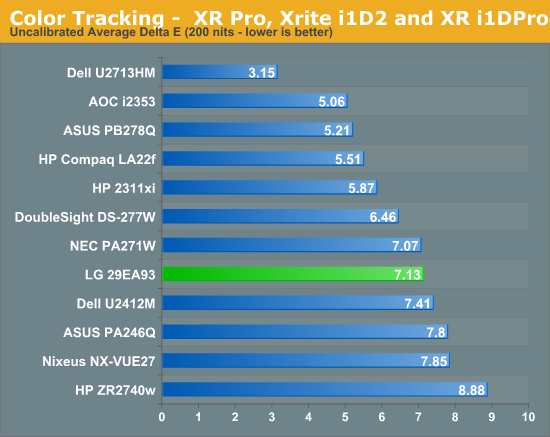
After a calibration, the LA 29EA93 fares much better. The average dE drops to a very respectable 1.61, and has a very low median dE of 1.33 as well. The main errors that are present are those that are hard for all displays to reproduce, such as certain blues, so this is a very nice calibrated result in the end for the LG.

When set to 100 nits that is more likely to be used for print media applications, the 29EA93 continues to have very nice calibrated results. The grayscale is nice and neutral, the colors are mostly accurate, and the resulting image is very nice on screen. Once calibrated the, LG 29EA93 produces an image that can keep up with the other IPS monitors out there.
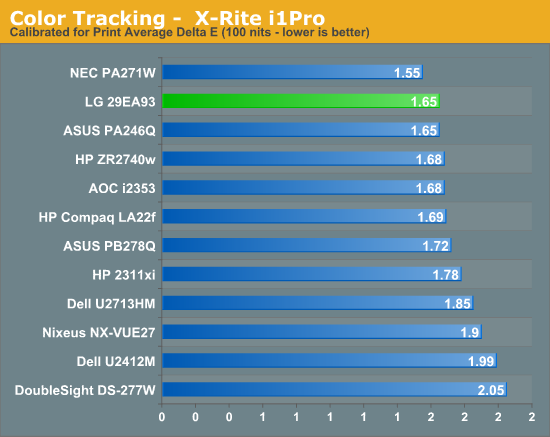
The one area that is does fall a bit short is in color gamut. It only covers 74% of the AdobeRGB gamut, which leaves it just a little short of the whole sRGB gamut. This little bit might not matter much in regular use, but it might matter more to those that are considering using it for color critical work.
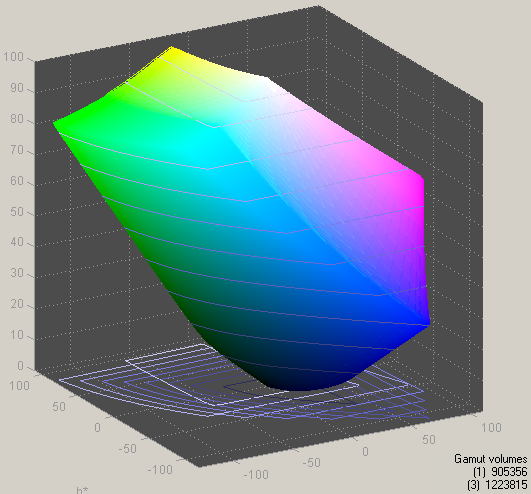
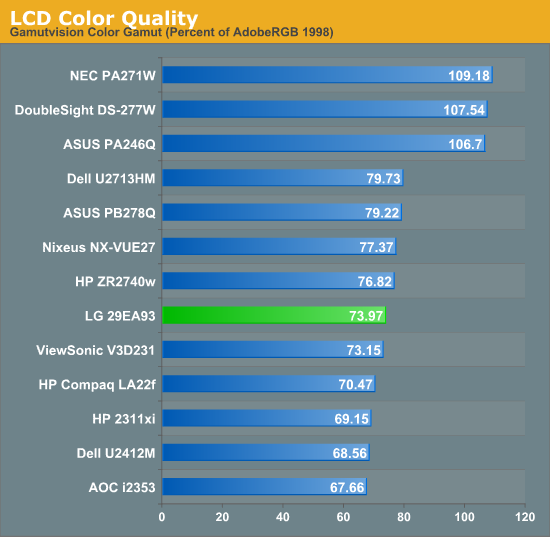


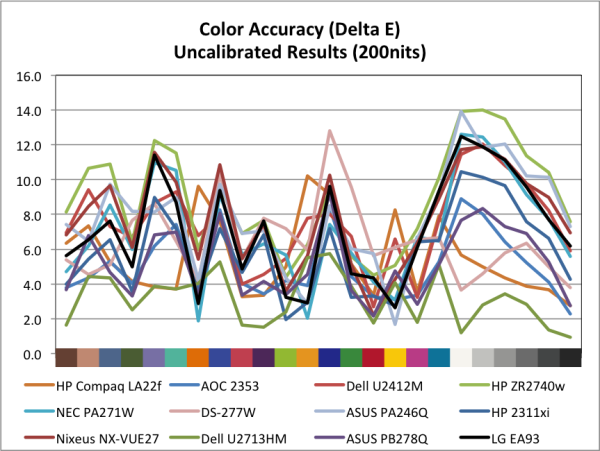
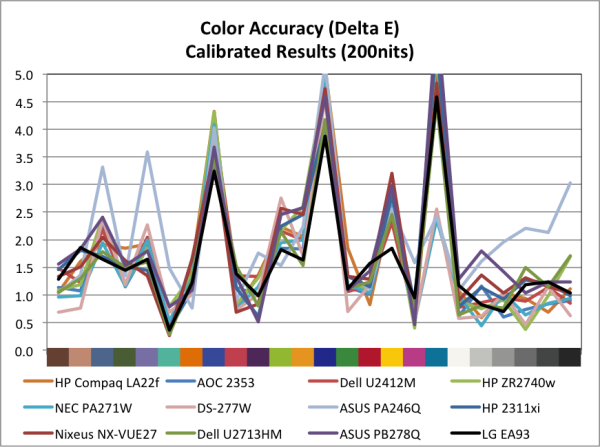
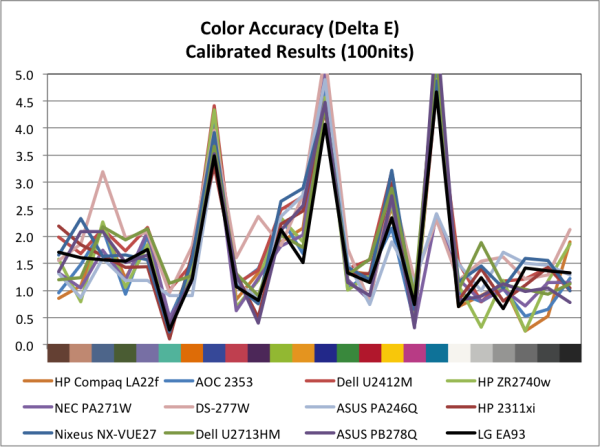








90 Comments
View All Comments
Rick83 - Tuesday, December 11, 2012 - link
So you say " In my very casual use this didn’t bother me"...and then use that as your main argument against the screen?
That is somewhat strange. If you can only quantify the issue, but not qualify it, then you shouldn't use it as such a strong argument.
Finally, it would be great to get a link back to the methodology used to measure monitor latency. Prad had a huuuge article on that, and I'm not even sure that the methodology you use is actually giving accurate results.
nathanddrews - Tuesday, December 11, 2012 - link
I don't think he was unclear. Input lag is really only a big issue when dealing with really fast action games. For slower paced games and cinefiles (assuming you can adjust latency of your audio source to match) input lag is not as important. So while I can understand the appeal of an extra-wide display for immersive gaming, the high latency of this display cancels that out.Prad? They established that lag testing applications are accurate enough. In the end, being accurate to 1fps is more than sufficient. Look at this chart showing the many different testing methods. They're all pretty close.
http://www.prad.de/en/monitore/specials/inputlag/i...
I will say that I am surprised that the display was tested at 1920x1080 rather than the native resolution. How do we know that the non-native resolution didn't contribute to observed latency? I guess I would have liked to see the native resolution tested to be sure. As a gamer and "cinefile", I would certainly attempt to run the monitor at its native resolution whenever possible, using FOV hacks as necessary.
Rick83 - Tuesday, December 11, 2012 - link
"Values which have been arrived using the old methods to date cannot be compared with these values, since their systematic errors alone often exceed the values from the new method multiple times."So clearly, the method that is used matters.
nathanddrews - Tuesday, December 11, 2012 - link
I understand, but the results - faulty or not - are roughly all within 1fps or real-world perception. Displays that have low latency using the old method still have low latency using the new methods, likewise with high latency. Other than objective purity, it doesn't seem to matter.cheinonen - Tuesday, December 11, 2012 - link
I haven't written up how SMTT is used, but TFT Central did a very through write-up of it in comparison to other methods and how the results were here:http://www.tftcentral.co.uk/articles/input_lag.htm
I plan for an article going over all of the testing methods in more detail soon.
jjj - Tuesday, December 11, 2012 - link
Not very sure why you asume the target was movies, i see that more as an unintended benefit and this as just an alternative to using 2x1080p screens.Maybe you would be happier with higher vertical res,guess there is no reason for them to not to that too at some point.The pricing is rather unfortunate, the Dell was quite a bit cheaper on BF and the input lag takes away so much of the benefit of having this AR.
Wish someone (hint Samsung) would make a 3420x1440 (more or less) with flexible display where the curve can be adjusted.That would be way fun,maybe even help revive a bit PC gaming.
cheinonen - Tuesday, December 11, 2012 - link
The movie assumption comes more from the presence of dual HDMI inputs, a CMS, and an MHL input than from the aspect ratio. Those lean more towards it being a shared desktop and TV/Gaming display, and once it's used for that then movies come more into play. Without the extra inputs and control I'd think it's more likely a dual monitor replacement. I think it's a bit of both, but needs some work.wsaenotsock - Tuesday, December 11, 2012 - link
So this is how laptop screens will look in 5 years after this ratio catches on and homogenizes the global panel supply again?madmilk - Wednesday, December 12, 2012 - link
You could buy a Macbook.peterfares - Wednesday, December 12, 2012 - link
I really hope this doesn't happen. 16:10 was so much better for computer usage, but 16:9 is still acceptable. This is just stupud. 27" WQHD screens are cheaper and much better, too.